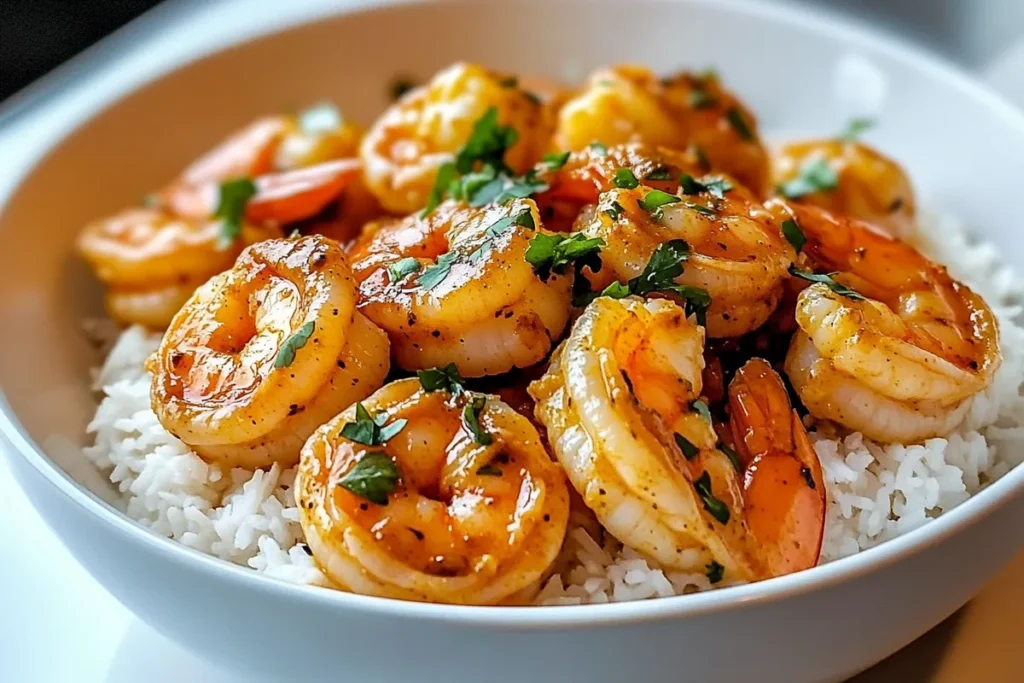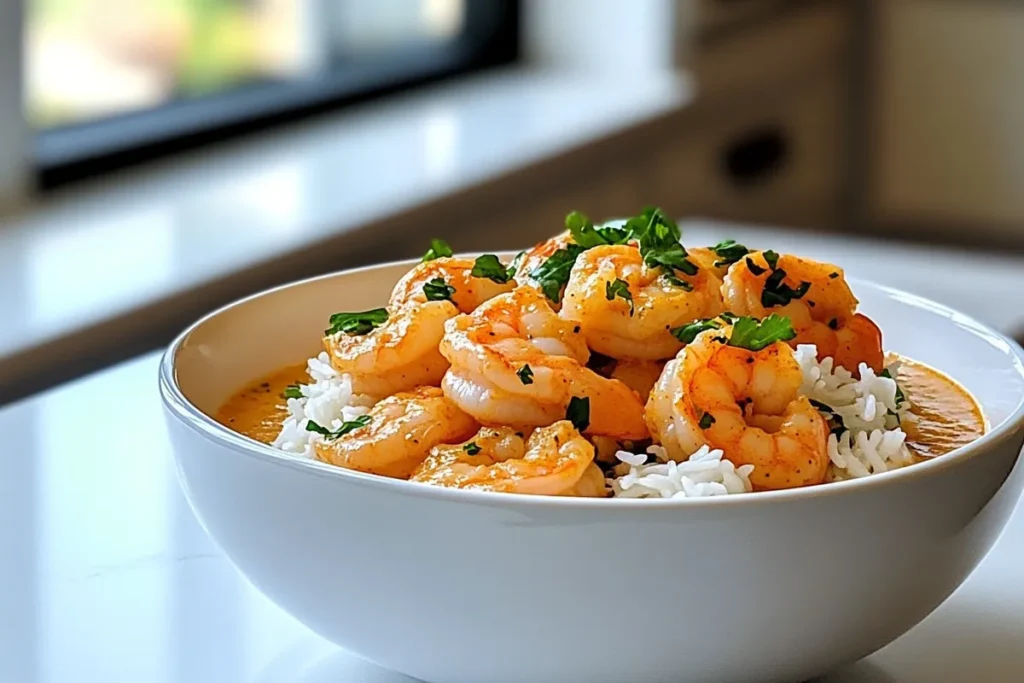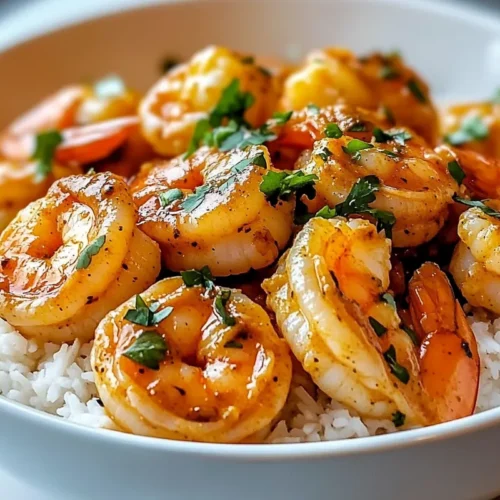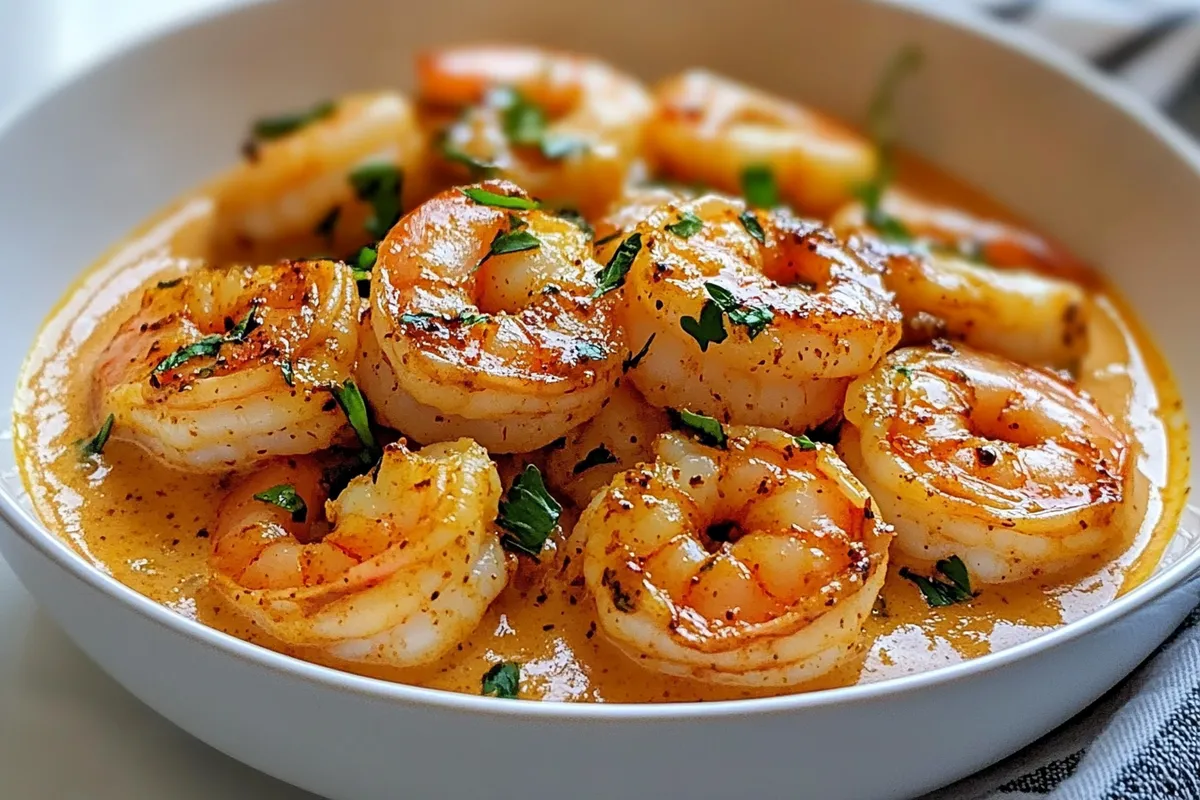Imagine a dish that combines the tropical sweetness of coconut with the fragrant spices of curry, creating a symphony of flavors that dance on your palate. Coconut Curry Shrimp is not only a delight for your taste buds but also a feast for the eyes, with its vibrant colors and enticing aromas. This dish can be easily customized to fit your dietary preferences; for instance, you could substitute shrimp with chicken or tofu for a vegetarian option, while adding vegetables like bell peppers or snap peas can enhance both texture and nutrition.
To achieve the perfect balance of flavors, consider using fresh herbs like cilantro or basil as a finishing touch. Additionally, bringing your curry to life can be as simple as selecting the right coconut milk—full-fat for a creamy texture or light for a lighter dish. Join us as we dive into this easy yet impressive recipe that promises to transform your dinner table into a culinary paradise!

Ingredients for Coconut Curry Shrimp:
To prepare a delectable coconut curry shrimp dish that serves 8–10 people, you’ll need the following ingredients. This recipe marries fresh shrimp with aromatic spices and coconut milk, creating a vibrant and flavorful experience.
Seafood Ingredients:
- 2 lb large shrimp, peeled and deveined (approximately 32-40 shrimp)
- ½ lb small bay shrimp, peeled (optional for added texture)
Vegetables:
- 1 medium onion, finely chopped
- 4 cloves garlic, minced
- 2 tablespoons fresh ginger, minced or grated
- 1 red bell pepper, sliced
- 1 green bell pepper, sliced
- 1 cup snap peas, trimmed
- 2 cups baby spinach leaves, packed
Curry Base:
- ½ cup coconut oil (or vegetable oil for a lighter flavor)
- 2 tablespoons red curry paste (adjust for spice preference)
- 2 teaspoons turmeric powder
- 1 teaspoon cumin powder
- 1 tablespoon coriander powder
Coconut Milk and Broth:
- 2 cans (13.5 oz each) coconut milk, full-fat for creaminess
- 1 cup vegetable broth or seafood stock
Seasonings and Garnish:
- 2-3 tablespoons fish sauce (or soy sauce for vegetarian option)
- 1 tablespoon sugar (to balance flavors)
- Juice of 1 lime, plus lime wedges for serving
- Fresh cilantro, chopped for garnish
Optional Additions:
- 2 julienned carrots for additional crunch and color
- 1 cup cherry tomatoes, halved, for a burst of sweetness
- 1-2 Thai bird’s eye chilies, sliced (for extra heat)
- Substitute shrimp with firm tofu for a vegetarian version, or combine both for a surf-and-turf twist.
Gather these vibrant ingredients, and you’ll be ready to immerse yourself in the rich flavors of this inviting dish. Experiment with varying levels of heat and acidity to suit your preference!

How to prepare Coconut Curry Shrimp:
Creating a flavorful coconut curry shrimp dish is a delightful process. Follow these instructions step by step for a perfect meal!
Gather Ingredients for Coconut Curry Shrimp
Begin by collecting all the necessary ingredients. You will need 1 pound of shrimp, peeled and deveined, 1 can (13.5 oz) of coconut milk, 2 tablespoons of curry powder, and 1 tablespoon of olive oil. Also, gather one onion, 2 cloves of garlic, 1 tablespoon of ginger, and 1 cup of bell peppers, chopped. Don’t forget to grab fresh cilantro for garnish!
Sauté Aromatics for Flavor
Heat the olive oil in a large skillet over medium heat. Add the chopped onion, cooking until translucent, approximately 5 minutes. Next, stir in minced garlic and grated ginger. Sauté for an additional 2 minutes to awaken the aromas.
Add Spices and Bell Peppers
Sprinkle the curry powder into the skillet and stir well. Cook for about 1 minute, which helps release the spices’ flavors. After that, toss in the chopped bell peppers, mixing to combine all the ingredients, and sauté for another 3 minutes.
Pour in Coconut Milk
Next, pour the entire can of coconut milk into the skillet. Stir the mixture well to combine the coconut milk with the sautéed vegetables and spices. Bring the mixture to a gentle simmer for about 5 minutes. This will allow the flavors to meld together beautifully.
Cook the Shrimp
Once the sauce simmers, add the shrimp to the skillet. Stir gently to coat the shrimp evenly with the curry sauce. Cook for about 5-7 minutes until the shrimp turns pink and opaque. Be careful not to overcook them to maintain a tender texture.
Garnish and Serve
When the shrimp is cooked, remove the skillet from the heat. Taste the dish and adjust seasoning if necessary, adding salt or additional curry powder for more flavor. Finally, garnish with freshly chopped cilantro before serving.
Serve your coconut curry shrimp hot over steamed rice or noodles for a complete meal!
Tips for the Perfect Coconut Curry Shrimp
Making a delicious, creamy coconut curry dish with shrimp requires careful attention to detail. Here are some helpful tips to ensure you achieve the best results.
Maintain the Correct Temperature
Cooking shrimp correctly is essential. Start with a hot pan or wok to quickly sear the shrimp, ensuring they stay juicy. If the pan is too cold, the shrimp may become rubbery. Use medium-high heat and monitor the temperature closely. Once they turn pink, remove them promptly to avoid overcooking. Remember, they’d continue to cook even after you take them off the heat.
Use Quality Ingredients
The flavor of this dish hinges on the quality of the ingredients. Select fresh, high-quality shrimp, preferably wild-caught. Fresh ingredients like garlic, ginger, cilantro, and vegetables make a noticeable difference. Similarly, opt for full-fat coconut milk for a rich taste and creamy texture. Avoid canned coconut milk with preservatives, as they can alter the flavor profile.
Substitutions for Dietary Restrictions
Catering to dietary needs doesn’t mean sacrificing flavor. For those allergic to shellfish, switch to chicken or firm tofu as a protein source. Ensure you adjust cooking times accordingly; chicken will take longer, while tofu absorbs the curry flavors beautifully. For a vegan version, use vegetable broth instead of fish sauce and add veggies such as zucchini or bell peppers to replace shrimp.
Enhancing Flavors with Spices
To elevate your curry, consider experimenting with spices. Fresh herbs like basil or mint can add brightness, while lime juice brings acidity that balances richness. You may also try adding turmeric or coriander for deeper flavor. Adjust spice levels to your taste by adding chili flakes or using a milder curry paste.
Garnishing for Aesthetic Appeal
Presentation enhances the enjoyment of your dish. Use fresh cilantro or thinly sliced green onions to garnish. Toasted coconut flakes can add texture and visual appeal as well. Serve the dish over a bed of jasmine rice or alongside warm naan to soak up the wonderful curry sauce.
By following these tips, you can craft a delightful and satisfying meal that everyone will enjoy. With the right balance of ingredients and careful attention to cooking processes, your next coconut curry adventure will surely impress!
Storage Tips for Coconut Curry Shrimp:
Storing your coconut curry shrimp properly helps maintain its freshness and flavor for future enjoyment. Follow these tips to keep this delicious dish in top condition.
Optimal Storage Conditions
Always let the shrimp cool down to room temperature before storing. Placing hot curry in the refrigerator can raise the internal temperature, potentially compromising the safety of other items. Use an airtight container to prevent air exposure, which can cause spoilage. Glass or BPA-free plastic containers are excellent choices because they seal tightly and help retain flavor.
Using the Refrigerator
Store coconut curry shrimp in the refrigerator if you plan to eat it within 3 to 4 days. Ensure you place it on a middle shelf rather than the door, where temperatures fluctuate more. Label the container with the date of preparation to keep track of freshness.
Freezing for Longer Storage
If you want to enjoy your dish later, freezing is the best option. Portion the shrimp into individual servings in freezer-safe bags or airtight containers, leaving some space at the top to allow for expansion. Label each container with the date before placing it in the freezer. Coconut curry shrimp can last for up to 3 months in the freezer without significant loss of quality.
Thawing and Reheating Tips
When you’re ready to eat your frozen coconut curry shrimp, transfer it to the refrigerator to thaw overnight. This gradual thawing process retains texture and flavor. You can also use the microwave to thaw leftovers quickly. Once thawed, reheat the shrimp on the stove over medium heat, stirring gently. Add a splash of coconut milk or water if the curry seems too thick after freezing. Ensure the shrimp reaches an internal temperature of 165°F before serving for optimal safety.
Additional Considerations
Avoid reheating the shrimp multiple times, as this can lead to loss of quality and safety concerns. Consume any leftovers within 3 days of reheating. By following these storage tips, you can prolong the life of your dish and savor the rich, tropical flavors whenever you desire.
Related Recipes to Explore
If you enjoy Coconut Curry Shrimp, you will love these similar dishes that share vibrant flavors and rich sauces. Each recipe offers unique ingredients while keeping the spirit of aromatic spices and delightful textures.
- Thai Green Curry Chicken
This dish features tender chicken simmered in savory green curry paste, coconut milk, and a variety of vegetables. Similar to the shrimp curry, the green curry brings together the creaminess of coconut milk and a medley of flavors. You’ll find that both recipes create a comforting, fragrant dish perfect for serving over rice. - Vegetable Coconut Curry
For a plant-based option, try this vegetable coconut curry that showcases seasonal vegetables like bell peppers, zucchini, and spinach. It uses the same coconut milk base, giving a creamy texture that complements the green seasonings. This dish makes a fantastic pairing if you’d like a meatless version to enjoy alongside your coconut shrimp. - Spicy Mango Salsa
A fresh mango salsa adds a zesty element to any seafood dish. The sweetness of ripe mango and the heat of jalapeños balance well with the rich flavors of coconut curry. Serving this salsa as a side enhances the overall meal experience with refreshing contrast. - Lemon Herb Quinoa
Serve a side of lemon herb quinoa for a wholesome grain that absorbs sauces beautifully. The citrus notes brighten up the dish and complement the exotic spices typically found in curry recipes. Quinoa’s fluffy texture provides a perfect contrast to the creamy consistency of the shrimp.
Each of these recipes enhances your dining experience with flavors that complement the spices and richness found in Coconut Curry Shrimp. Enjoy exploring these options for a delightful meal spread!
Frequently Asked Questions:
What is Coconut Curry Shrimp?
Coconut Curry Shrimp is a delicious seafood dish that combines succulent shrimp with a rich and creamy coconut milk-based curry sauce. This dish is often infused with aromatic spices, fresh herbs, and vibrant vegetables, creating a delightful balance of flavors. It is popular in various cuisines, particularly in Thai and Indian cooking, where coconut and curry are staple ingredients.
How do I make Coconut Curry Shrimp?
To prepare this delightful meal, start by sautéing onions, garlic, and ginger in a bit of oil. Add your choice of curry paste, followed by coconut milk and the shrimp. Allow the mixture to simmer until the shrimp is cooked through, and season it with lime juice and fresh herbs. Serve over rice or alongside naan for a truly satisfying experience.
Can I use frozen shrimp for this dish?
Yes, frozen shrimp can be used for making Coconut Curry Shrimp. Just ensure to thaw the shrimp properly before adding them to the curry. For best results, place them in the refrigerator overnight or run them under cold water until defrosted. This helps achieve a better texture while cooking.
What vegetables pair well with coconut curry?
Incorporating vegetables not only enhances the dish but also adds nutrition. Bell peppers, snap peas, spinach, and zucchini work exceptionally well, offering a nice crunch and color. You can also experiment with eggplant or carrots to achieve different textures and flavors in your coconut-infused dish.
Can I make this shrimp dish gluten-free?
Coconut Curry Shrimp is naturally gluten-free as long as you ensure that any sauces or curry pastes used do not contain gluten ingredients. Always check labels to confirm, and opt for fresh and whole ingredients when possible to maintain a gluten-free profile.
How can I make Coconut Curry Shrimp spicier?
If you prefer a spicier version, consider adding fresh chopped chilies, a spicy curry paste, or red pepper flakes to the dish. Adjust the heat level gradually, tasting as you go, to achieve the perfect balance that suits your palate without overwhelming the other flavors in the dish.
Conclusion:
In summary, this vibrant Coconut Curry Shrimp recipe is a delightful dish that combines simplicity with endless flexibility. With a few basic ingredients, you can whip up a delicious meal in no time, making it perfect for busy weeknights or entertaining guests. One of the highlights is the ability to customize flavors by adjusting the spices or adding seasonal vegetables—feel free to get creative! Additionally, cooking shrimp in a creamy coconut sauce not only allows for a rich taste but also provides a satisfying texture that pairs well with rice or noodles. Whether you enjoy it spicy or mild, this adaptable recipe caters to every palate. Embrace the versatility it offers and enjoy a tropical flair in your kitchen with this easy Coconut Curry Shrimp dish.

Coconut Curry Shrimp
Ingredients
• 1 tablespoon curry powder
• 1 lb large shrimp, peeled and deveined
• 1 tablespoon lime juice
• 1 can (14 oz) coconut milk
• 1 tablespoon olive oil
• 1 onion, chopped
• 2 garlic cloves, minced
• 1 tablespoon ginger, grated
• 1/4 teaspoon salt (or to taste)
• 1/4 teaspoon black pepper
• 1/2 teaspoon chili powder
• Fresh cilantro for garnish (optional)
Instructions
1. Heat Oil & Cook Onion:Heat olive oil in a large skillet over medium heat. Add the chopped onion and sauté for 2-3 minutes until softened.
2. Add Garlic & Ginger:Add the minced garlic and grated ginger. Cook for 1 minute until fragrant, stirring frequently to prevent burning.
3. Add Spices:Stir in the curry powder, chili powder, salt, and black pepper. Mix everything well to combine.
4. Create the Sauce:Pour in the coconut milk, ensuring the spices are well mixed. Bring to a gentle simmer and cook for 5-7 minutes to thicken.
5. Cook the Shrimp:Add the shrimp and cook for 3-4 minutes until they turn pink and opaque.
6. Final Touches:Stir in the lime juice for a zesty finish. Adjust seasoning if needed.
7. Serve:Garnish with fresh cilantro if desired. Serve hot over steamed rice or with warm naan bread.

